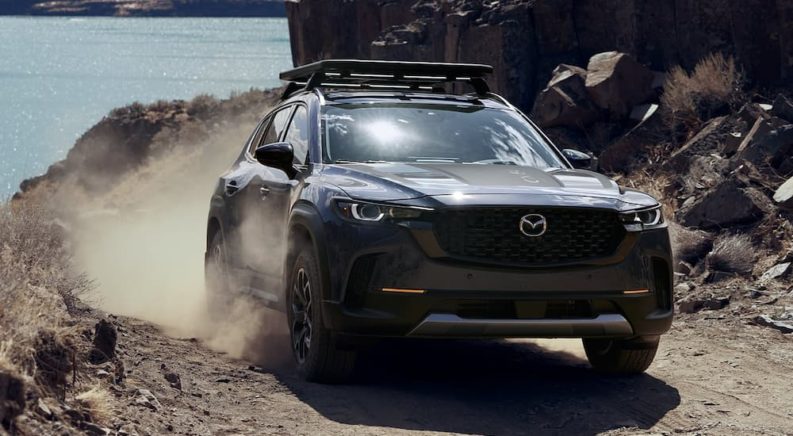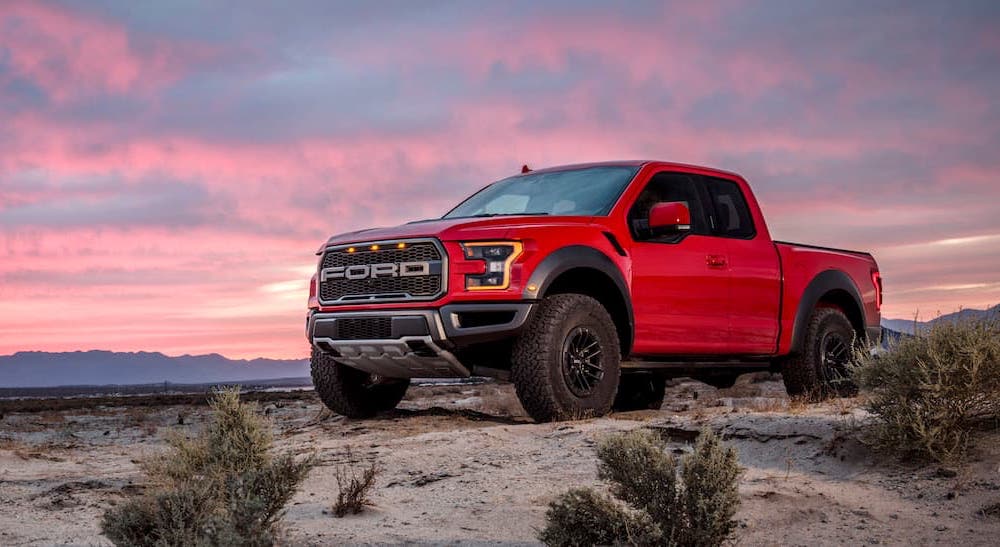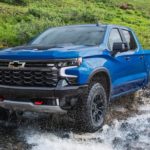Drivers seeking off-road-ready vehicles now have more choices than ever. While the pursuit was previously reserved for those with off-road specific rigs or four-wheel drive vehicles souped up to handle off-road fun, a new breed of SUV has entered the fray. These vehicles offer much of the same heavy-duty equipment as the competition, but also make great everyday vehicles thanks to their smaller size and efficiency. Mazda is the latest automaker to get in on the game, unveiling the 2022 Mazda CX-50 SUV while other brands launch off-road-specific versions of some of their most popular models.
Mazda’s new crossover SUV doesn’t just look the part; it also has the off-road components to back its aggressive appearance. The CX-50 features Mazda’s well-reviewed i-Activ all-wheel-drive system, which, when combined with the intelligent Mi-Drive driving style selector, allows the SUV to transcend the rest of Mazda’s lineup and become a true light off-roader. Mi-Drive has been offered on a number of Mazda models to date, letting drivers choose between Normal, Sport, and Towing modes, but the CX-50 is the first to include a new Off-Road mode.
When Off-Road mode is activated, the CX-50 can adjust its transmission and brake-based traction control system to improve low-speed grip and detect when the vehicle is headed for an incline, adjusting the ideal speed in anticipation. At the heart of the new Off-Road mode is Mazda’s G-Vectoring Control system, which adjusts engine torque between the front and back wheels and aids steering to produce a smoother, easier off-road experience. The CX-50 is also wider and longer than its predecessors, the CX-5, with this larger footprint to further improve traction and handling. With these new technologies and designs under the hood, the CX-50 becomes an instant contender in the growing light off-road category.
As more drivers leave well-paved roads behind for a taste of adventure, they’re beginning to discover that off-roading is really an umbrella term that encompasses a number of distinct activities. When we think of off-roading, most of us might picture big, lifted trucks splashing through muck and fording creeks, but that just scratches the surface. From dune bashing and green laning to mudding and rock crawling, there are countless ways to put your off-road vehicle to the test. Let’s explore some of the more popular forms of off-roading—then look into the equipment and vehicles best suited for each job.
Types of Off-Roading
Dune Bashing
- Difficulty: High
- Recommended gear: Beadlock rims, all-terrain tires, roll cage
- Ideal vehicles: Ford F-150 Raptor, Toyota Land Cruiser, Subaru Forester
Different types of off-roading are categorized by the surface one navigates, so you only get one guess as to where “dune bashing” takes place. This form of off-roading involves traversing sand dunes in a four-wheel drive vehicle, taking on steep inclines without getting stuck—or worse, rolling over. Dune bashing is one of the more advanced forms of off-roading and is generally not recommended for beginners, as the shifting sands can present some real challenges for those who don’t know all the tricks of the trade.
As with many forms of off-roading, the keyword here is “traction”, so before you set out for the desert it’s important to do a little preparation. The easiest way to improve traction is to let air out of the tires themselves, upping the tires’ surface area and allowing them to essentially float on top of the sand—instead of sinking down into it. Air pressure can be reduced by as much as half—say, from 35 PSI to as little as 15 PSI—in order to improve traction, but that’s just the first step. All-terrain tires will offer improved traction over their standard counterparts, but if you’re really looking to step it up a notch, consider investing in beadlock rims. These unique rims prevent the tire from separating from the rim, which is particularly useful if you plan on drastically lowering the PSI.
Lastly, those who are looking to do some serious dune bashing should invest in a roll cage. Surrounding the driver with reinforced bars, roll cages go a long way toward preventing injury should the vehicle flip. Be warned, though: While such modifications can make all the difference when it comes to safety, they also effectively turn a vehicle into a dedicated off-roader that’s no longer really suitable for everyday driving.
Green Laning
- Difficulty: Low
- Recommended gear: None
- Ideal vehicles: Mazda CX-50, Toyota Land Cruiser
For those looking to start small with their off-road adventures, green laning provides the perfect entrée into the sport. This form of off-roading is the least intensive by far and basically just involves driving along unpaved roads, forest tracks, or unused roadways. Also known as “two-tracking”, the activity takes its name from the overgrown roads that have become covered in greenery—aside from the two tracks that tires leave behind. Green laning doesn’t require any specialized off-roading equipment—aside from four-wheel drive—making it accessible for a wide range of drivers. This type of low-investment off-roading is a great way to get accustomed to your vehicle’s capabilities, so drivers can work out some kinks and gain a little practice before setting off to more challenging environments.
Drivers don’t usually need to look far to find trails that are ideal for green laning, though it can depend on what part of the country you’re in. State parks often feature plenty of rugged dirt roads that are ideal for this type of leisurely driving, but they often come with speed restrictions and other rules that can temper the fun a bit. Those looking for a slightly more permissive green lane experience should look into nearby state- or federally-managed land, which often features plenty of trails and wide-open spaces perfect for all types of off-roading. Again, there are rules to be followed, but they’re a whole lot less onerous than the ones you’ll get pulled over for on a regular paved road. Ultimately green laning really isn’t about speed or thrills; rather, it’s like the Sunday driving of the off-road scene—more about the overall experience than any particular death-defying stunt you might pull off.
Rock Crawling
- Difficulty: High
- Recommended gear: All-terrain tires, lift kits, rock sliders, differential covers, winch kits, reinforced bumpers
- Ideal vehicles: Ford SuperDuty Tremor, Ram 2500HD Power Wagon, Jeep Gladiator Rubicon
For those who aren’t afraid of a challenge, rock crawling is easily one of the most exciting niches in off-road driving. While lighter off-roading involves navigating difficult, loose terrain, it’s nothing compared to the cliff-scaling antics that rock crawlers can get up to. Rock crawling involves putting your vehicle in 4WD, finding a suitably steep surface, and slowly making your way to the top. To be clear, this isn’t exactly a high-octane activity; with the vehicle in 4WD Lo, you won’t be going anywhere fast, but the thrill of scaling a slope up to 75 degrees should be more than enough to get your blood pumping. Rock crawling is up there with dune bashing in terms of technical difficulty, so this is one off-road activity you’ll want to work your way up to as you become more comfortable behind the wheel.
Since most automakers don’t design vehicles to be driven up sheer cliffs, rock crawling requires more of an investment and more comprehensive modifications than the average off-road rig. This doesn’t just mean larger, grippier tires and a reinforced bumper, but also components such as lift kits and winch kits—as well as rock sliders and differential covers to protect the underside of the vehicle from whatever craggy surface you’re trying to surmount.
However, the most important tool in the world of rock crawling isn’t a tool at all; it’s a person. Having a spotter is essential for any successful rock crawling escapades. Given the extreme angles that rock-crawling drivers often find themselves in, it can be difficult to keep tabs on the surrounding terrain. This is where spotters come in. They can identify any unseen obstacles, warn you about upcoming hazards, or just provide a good sounding board for whatever half-baked maneuver you’re about to attempt.
Overlanding
- Difficulty: Medium
- Recommended gear: All-terrain tires, off-road suspension, rooftop tent
- Ideal vehicles: Lexus GX460/GX470, Ford Bronco, Chevy Colorado
Overlanding is a unique form of off-roading that, like green laning, is more about the journey than any particular off-road stunts. The real difference comes down to duration, as overlanding trips tend to be multi-day (or week) excursions that include camping, hiking, sightseeing, and other activities that don’t strictly take place behind the wheel. Think of it like car camping, but kicked up a notch and venturing well off the beaten path. Unlike green laning, overlanding can take place on a wider array of terrain—some of it quite challenging—but nothing so crazy that it’ll endanger your supplies.
Overlanding traces its history to the Australian Outback, where literal trailblazer Len Beadell developed routes through the country’s harsh Outback. This grueling journey required a particularly hardy breed of automobile—and thus, the early overland off-roaders were born. While today’s overland adventures tend to be a little less trying, they can often span the course of weeks or even months, crossing state or international borders in the process.
A good overlanding rig will feature all-terrain tires and off-road-tuned suspension, but most of the important gear comes down to those supplies that are vital for any extended camping journey. These include first-aid kits, plenty of food and clean water, a water filter, and a stove. Those who don’t want to leave all the digital comforts of home behind can also invest in a portable solar setup, which uses a small solar array to power a lithium-ion battery pack—which, in turn, can keep your phone, camera, or computer juiced up at all times. You’ll also want to bring along extra fuel and a generous complement of spare parts.
For most overlanders, though, planning begins with sleeping accommodations. Roof-mounted tents have become all the rage as of late, and are the perfect addition to any overlanding setup. These tents are not only quick and easy to set up, but they also offer a better night’s sleep than the uneven ground—while conveniently protecting you from inclement weather or curious wildlife.
Mudding
- Difficulty: Medium
- Recommended gear: Mud-terrain tires, paddle tires, snorkel
- Ideal vehicles: Ram 1500 Rebel, Hyundai Kona Ultimate, Land Rover Range Rover
If your ideal off-road adventure ends in a 4×4 caked with grime, mudding is for you. This one is pretty self-explanatory, but for the uninitiated, mudding involves navigating directly through wet mud or clay with your 4WD vehicle. Finding an appropriate mudding destination can be tough, as it often depends on the season, weather, and recent rainfall. The pastime is best enjoyed on private property, as it can have considerable environmental effects and is illegal on most public land.
One need not outfit a mudding rig as thoroughly as rock crawlers or dune bashers, but there are a few key components to keep in mind. Depending on the depth of the mud holes you’re looking to rut around in, a snorkel might come in handy. These features essentially elevate your vehicle’s air intake port, which is important for off-roaders who are regularly submerging their vehicles in water or mud. A winch might also serve you well, allowing you to dislodge your vehicle from any uncooperative pits that you might find yourself in.
Don’t skimp on tires, either. Given the wet, muddy surfaces that these vehicles find themselves in, regular tires just won’t cut it; they’re too prone to sinking or getting caked with dirt. That’s where mud-terrain tires come in. These specialized tires have an aggressive tread pattern and wide, deep tread blocks that are perfect for gripping muddy surfaces. These tires are also designed to eject stones and mud that can clog up the treads and, unlike most tires, have tread built into the sidewall of the tire itself for added traction.
Then there are paddle tires. For off-roaders who regularly find themselves navigating deep mud or sand, nothing helps you get a grip quite like paddle tires. These tires look almost bare compared to most off-road skids—aside from the large, rubberized paddles that are spaced along the surface. These paddles do a great job scooping aside mud and sand with virtually no risk of getting gunked up, making them perfect for certain off-road roles.
From gravity-defying stunts like dune bashing and rock crawling to more slow-paced excursions like green laning and overlanding, there’s a form of off-roading to satisfy every driver. Just explore which type matches your experience, equipment, and comfort level. As more and more automakers increase their vehicles’ off-road capabilities, the pursuit is now open to more drivers than ever before—making it the perfect time to try it out yourself.
Off-roading isn’t just a fun hobby, it’s also a chance to build some confidence behind the wheel. Those off-road skills developed on the trail could serve you well next time you’re faced with inclement weather, giving you the experience necessary to deal with deep snow, loose gravel or any other hazards you might encounter. Most drivers never get the chance to truly test their vehicle’s limits, but off-roading provides a great excuse to push the envelope and see just what your ride is capable of. No matter what type of off-roading you decide to explore, you’ll soon discover that there’s a lot of fun to be had in leaving paved roads behind.





